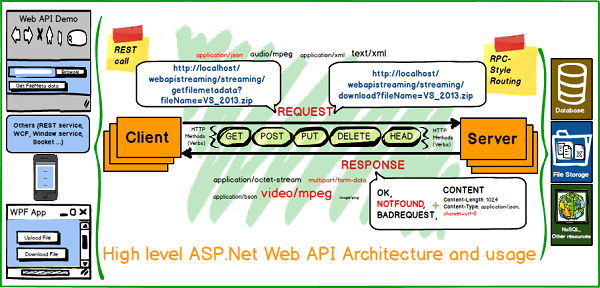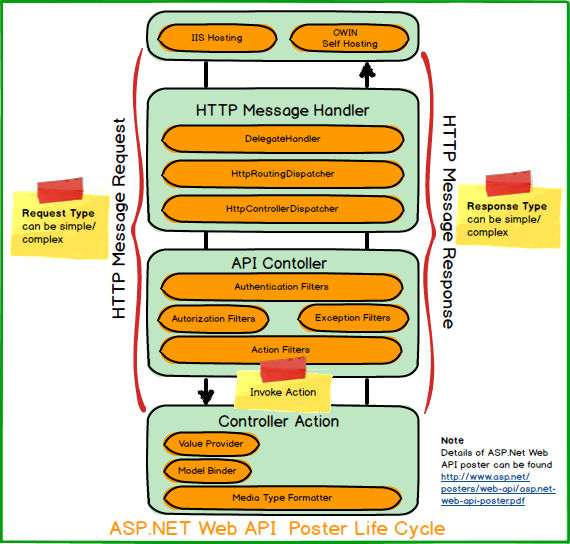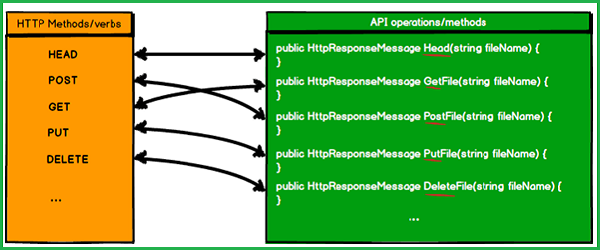标签:

相信已经有很多文章来介绍ASP.Net Web API 技术,本系列文章主要介绍如何使用数据流,HTTPS,以及可扩展的Web API 方面的技术,系列文章主要有三篇内容。
主要内容如下:
I 数据流
II 使用HTTPS
III 可扩展的Web API 文档
.Net 框架
前言

自从ASP.NET MVC 4之后.Net 框架开始支持ASP.NET Web API ,ASP.NET Web API 基于HTTP 协议建立的,是构建 RESTful 服务和处理数据的理想平台,旨在使用HTTP 技术实现对多平台的支持。
ASP.NET Web API 以request-response 的消息转换模式为主,客户端向服务器发送请求,服务器端响应客户端请求。响应可同步或异步。
个人认为使用Web API创建应用需要注意的三个关键点:
通常情况下,Asp.Net Web API 定义method语法与HTTP方法一一对应的,如自定义方法名 GetPysicians(),则与HTTP中Get 方法匹配。下图是常用匹配表。

但是此方法在很多情况下,并不实用,假如你想在单个API controller 类中定义多个Get 或Post 方法,在这种情况下,需要定义包含action 的路径,将Action 作为URI 的一部分。以下是配置代码:
1: public static void Register(HttpConfiguration config)
2: {3: // Web API configuration and services
4: // Web API routes
5: config.MapHttpAttributeRoutes(); 6: 7: config.Routes.MapHttpRoute(name: "PhysicianApi",
8: routeTemplate: "{controller}/{action}/{id}",
9: defaults: new { id = RouteParameter.Optional });
10: }但是此方法不足以应对所有情况,如果想实现从中央仓库删除文件,并且想调用同一个方法来获取文件,这种情况下,Web API 框架需要伪装Get 及Delete对应的HTTP 方法属性。如图所示:

RemoveFile 方法可被Delete(HttpDelete) 或 Get(HttpGet)方法同时调用,从某种程度来说,HTTP 方法使开发人员命名 API“方法”变得简单而标准。
Web API框架也提供了一些其他功能来处理路径方面的问题,与MVC 的路径处理方法相似。因此可定义不同类型的Action方法。
数据流网络App 最常见的执行操作就是获取数据流。ASP.NET Web API 能够处理客户端与服务器端传输的重量级的数据流,数据流可来源于目录文件,也可是数据库中的二进制文件。本文主要介绍两种方法“Download”和“Upload”实现数据流相关的功能,Download是从服务器下载数据操作,而Upload则是上传数据到服务器。
WebAPIDataStreamingWebAPIClientPOCOLibrary在对代码解释之前,首先来了解如何配置IIS(7.5)和Web API 服务Web.Config 文件。
1. 保证Downloads/Uploads 涉及的文件具有读写权限。
2. 保证有足够容量的内容或因公安空间处理大文件。
3. 如果文件较大
a. 配置Web.Config 文件时,保证maxRequestLength 时响应时间executionTimeout 合理。具体的值主要依赖于数据大小,允许一次性上传的最大数据为2 GB
b. 保证
maxAllowedContentLength 在requestFiltering部分配置下正确设置,默认值为30MB,最大值4GB
一旦完成预先配置,那么创建数据流服务就非常简单了,首先 需要定义文件流“ApiController”,如下:
1: /// <summary>
2: /// File streaming API
3: /// </summary>
4: [RoutePrefix("filestreaming")]
5: [RequestModelValidator]6: public class StreamFilesController : ApiController
7: {8: /// <summary>
9: /// Get File meta data
10: /// </summary>
11: /// <param name="fileName">FileName value</param>
12: /// <returns>FileMeta data response.</returns>
13: [Route("getfilemetadata")]
14: public HttpResponseMessage GetFileMetaData(string fileName)
15: {16: // .........................................
17: // Full code available in the source control
18: // .........................................
19: 20: } 21: 22: /// <summary>
23: /// Search file and return its meta data in all download directories
24: /// </summary>
25: /// <param name="fileName">FileName value</param>
26: /// <returns>List of file meta datas response</returns>
27: [HttpGet]28: [Route("searchfileindownloaddirectory")]
29: public HttpResponseMessage SearchFileInDownloadDirectory(string fileName)
30: {31: // .........................................
32: // Full code available in the source control
33: // .........................................
34: } 35: 36: /// <summary>
37: /// Asynchronous Download file
38: /// </summary>
39: /// <param name="fileName">FileName value</param>
40: /// <returns>Tasked File stream response</returns>
41: [Route("downloadasync")]
42: [HttpGet]43: public async Task<HttpResponseMessage> DownloadFileAsync(string fileName)
44: {45: // .........................................
46: // Full code available in the source control
47: // .........................................
48: } 49: 50: /// <summary>
51: /// Download file
52: /// </summary>
53: /// <param name="fileName">FileName value</param>
54: /// <returns>File stream response</returns>
55: [Route("download")]
56: [HttpGet]57: public HttpResponseMessage DownloadFile(string fileName)
58: {59: // .........................................
60: // Full code available in the source control
61: // .........................................
62: } 63: 64: /// <summary>
65: /// Upload file(s)
66: /// </summary>
67: /// <param name="overWrite">An indicator to overwrite a file if it exist in the server</param>
68: /// <returns>Message response</returns>
69: [Route("upload")]
70: [HttpPost]71: public HttpResponseMessage UploadFile(bool overWrite)
72: {73: // .........................................
74: // Full code available in the source control
75: // .........................................
76: } 77: 78: /// <summary>
79: /// Asynchronous Upload file
80: /// </summary>
81: /// <param name="overWrite">An indicator to overwrite a file if it exist in the server</param>
82: /// <returns>Tasked Message response</returns>
83: [Route("uploadasync")]
84: [HttpPost]85: public async Task<HttpResponseMessage> UploadFileAsync(bool overWrite)
86: {87: // .........................................
88: // Full code available in the source control
89: // .........................................
90: } 91: }Download 服务方法首先需要确认请求的文件是否存在,如果未找到,则返回错误提示“file is not found”,如果找到此文件,内容则转换为字节附加到响应对象,为“application/octet-stream” MIMI 内容类型。
1: /// <summary>
2: /// Download file
3: /// </summary>
4: /// <param name="fileName">FileName value<param>
5: /// <returns>File stream response<returns>
6: [Route("download")]
7: [HttpGet]8: public HttpResponseMessage DownloadFile(string fileName)
9: { 10: HttpResponseMessage response = Request.CreateResponse();11: FileMetaData metaData = new FileMetaData();
12: try
13: {14: string filePath = Path.Combine(this.GetDownloadPath(), @"\", fileName);
15: FileInfo fileInfo = new FileInfo(filePath); 16: 17: if (!fileInfo.Exists) 18: { 19: metaData.FileResponseMessage.IsExists = false;20: metaData.FileResponseMessage.Content = string.Format("{0} file is not found !", fileName);
21: response = Request.CreateResponse(HttpStatusCode.NotFound, metaData, new MediaTypeHeaderValue("text/json"));
22: } 23: else 24: {25: response.Headers.AcceptRanges.Add("bytes");
26: response.StatusCode = HttpStatusCode.OK; 27: response.Content = new StreamContent(fileInfo.ReadStream());28: response.Content.Headers.ContentDisposition = new ContentDispositionHeaderValue("attachment");
29: response.Content.Headers.ContentDisposition.FileName = fileName;30: response.Content.Headers.ContentType = new MediaTypeHeaderValue("application/octet-stream");
31: response.Content.Headers.ContentLength = fileInfo.Length; 32: } 33: } 34: catch (Exception exception) 35: { 36: // Log exception and return gracefully 37: metaData = new FileMetaData(); 38: metaData.FileResponseMessage.Content = ProcessException(exception); 39: response = Request.CreateResponse(HttpStatusCode.InternalServerError, metaData, new MediaTypeHeaderValue("text/json")); 40: }41: return response;
42: }Upload服务方法则会在multipart/form-data MIMI 内容类型执行,首先会检测HTTP 请求的内容类型是否是多主体,如果是,则对比内容长度是否超过最大尺寸,如果没有超过,则开始上传内容,当操作完成之后,则提示相应的信息。
代码片段如下:
1: /// <summary>
2: /// Upload file(s)
3: /// </summary>
4: /// <param name="overWrite">An indicator to overwrite a file if it exist in the server.</param>
5: /// <returns>Message response</returns>
6: [Route("upload")]
7: [HttpPost]8: public HttpResponseMessage UploadFile(bool overWrite)
9: { 10: HttpResponseMessage response = Request.CreateResponse();11: List<FileResponseMessage> fileResponseMessages = new List<FileResponseMessage>();
12: FileResponseMessage fileResponseMessage = new FileResponseMessage { IsExists = false };
13: 14: try
15: {16: if (!Request.Content.IsMimeMultipartContent())
17: {18: fileResponseMessage.Content = "Upload data request is not valid !";
19: fileResponseMessages.Add(fileResponseMessage);20: response = Request.CreateResponse(HttpStatusCode.UnsupportedMediaType, fileResponseMessages, new MediaTypeHeaderValue("text/json"));
21: } 22: 23: else
24: { 25: response = ProcessUploadRequest(overWrite); 26: } 27: }28: catch (Exception exception)
29: {30: // Log exception and return gracefully
31: fileResponseMessage = new FileResponseMessage { IsExists = false };
32: fileResponseMessage.Content = ProcessException(exception); 33: fileResponseMessages.Add(fileResponseMessage);34: response = Request.CreateResponse(HttpStatusCode.InternalServerError, fileResponseMessages, new MediaTypeHeaderValue("text/json"));
35: 36: }37: return response;
38: } 39: 40: /// <summary>
41: /// Asynchronous Upload file
42: /// </summary>
43: /// <param name="overWrite">An indicator to overwrite a file if it exist in the server.<param>
44: /// <returns>Tasked Message response</returns>
45: [Route("uploadasync")]
46: [HttpPost]47: public async Task<HttpResponseMessage> UploadFileAsync(bool overWrite)
48: {49: return await new TaskFactory().StartNew(
50: () => 51: {52: return UploadFile(overWrite);
53: }); 54: } 55: 56: /// <summary>
57: /// Process upload request in the server
58: /// </summary>
59: /// <param name="overWrite">An indicator to overwrite a file if it exist in the server.</param>
60: /// </returns>List of message object</returns>
61: private HttpResponseMessage ProcessUploadRequest(bool overWrite)
62: {63: // .........................................
64: // Full code available in the source control
65: // .........................................
66: }调用download 及 upload 文件方法是控制台应用,App 假定文件流服务通过HttpClient和相关类。基本下载文件代码,创建下载HTTP 请求对象。
1: /// <summary>
2: /// Download file
3: /// </summary>
4: /// <returns>Awaitable Task object</returns>
5: private static async Task DownloadFile()
6: { 7: Console.ForegroundColor = ConsoleColor.Green;8: Console.WriteLine("Please specify file name with extension and Press Enter :- ");
9: string fileName = Console.ReadLine();
10: string localDownloadPath = string.Concat(@"c:\", fileName); // the path can be configurable
11: bool overWrite = true;12: string actionURL = string.Concat("downloadasync?fileName=", fileName);
13: 14: try 15: {16: Console.WriteLine(string.Format("Start downloading @ {0}, {1} time ",
17: DateTime.Now.ToLongDateString(), 18: DateTime.Now.ToLongTimeString())); 19: 20: 21: using (HttpClient httpClient = new HttpClient()) 22: { 23: httpClient.BaseAddress = baseStreamingURL; 24: HttpRequestMessage request = new HttpRequestMessage(HttpMethod.Get, actionURL); 25: 26: await httpClient.SendAsync(request, HttpCompletionOption.ResponseHeadersRead). 27: ContinueWith((response) 28: => 29: { 30: Console.WriteLine(); 31: try 32: { 33: ProcessDownloadResponse(localDownloadPath, overWrite, response); 34: } 35: catch (AggregateException aggregateException) 36: { 37: Console.ForegroundColor = ConsoleColor.Red;38: Console.WriteLine(string.Format("Exception : ", aggregateException));
39: } 40: }); 41: } 42: } 43: catch (Exception ex) 44: { 45: Console.ForegroundColor = ConsoleColor.Red; 46: Console.WriteLine(ex.Message); 47: } 48: } 49: 50: 51: /// <summary> 52: /// Process download response object 53: /// </summary>54: /// <param name="localDownloadFilePath">Local download file path</param>
55: /// <param name="overWrite">An indicator to overwrite a file if it exist in the client.</param>
56: /// <param name="response">Awaitable HttpResponseMessage task value</param>
57: private static void ProcessDownloadResponse(string localDownloadFilePath, bool overWrite,
58: Task<HttpResponseMessage> response) 59: {60: if (response.Result.IsSuccessStatusCode)
61: { 62: response.Result.Content.DownloadFile(localDownloadFilePath, overWrite). 63: ContinueWith((downloadmessage) 64: => 65: { 66: Console.ForegroundColor = ConsoleColor.Green; 67: Console.WriteLine(downloadmessage.TryResult()); 68: }); 69: }70: else
71: { 72: ProcessFailResponse(response); 73: } 74: }
注意上述代码中HttpClient 对象发送请求,并等待响应发送Header内容(HttpCompletionOption.ResponseHeadersRead )。而不是发送全部的响应内容文件。一旦Response header 被读,则执行验证,一旦验证成功,则执行下载方法。
以下代码调用upload 文件流,与下载方法类似,创建多主体表单数据,并发送给服务器端。
1: /// <summary>
2: /// Upload file
3: /// </summary>
4: /// <returns>Awaitable task object</returns>
5: private static async Task UploadFile()
6: {7: try
8: {9: string uploadRequestURI = "uploadasync?overWrite=true";
10: 11: MultipartFormDataContent formDataContent = new MultipartFormDataContent();
12: 13: // Validate the file and add to MultipartFormDataContent object
14: formDataContent.AddUploadFile(@"c:\nophoto.png");
15: formDataContent.AddUploadFile(@"c:\ReadMe.txt");
16: 17: if (!formDataContent.HasContent()) // No files found to be uploaded
18: { 19: Console.ForegroundColor = ConsoleColor.Red; 20: Console.Write(formDataContent.GetUploadFileErrorMesage());21: return;
22: }23: else
24: {25: string uploadErrorMessage = formDataContent.GetUploadFileErrorMesage();
26: if (!string.IsNullOrWhiteSpace(uploadErrorMessage)) // Some files couldn‘t be found
27: { 28: Console.ForegroundColor = ConsoleColor.Red; 29: Console.Write(uploadErrorMessage); 30: } 31: 32: HttpRequestMessage request = new HttpRequestMessage(HttpMethod.Post, uploadRequestURI);
33: request.Content = formDataContent; 34: 35: using (HttpClient httpClient = new HttpClient())
36: { 37: Console.ForegroundColor = ConsoleColor.Green;38: Console.WriteLine(string.Format("Start uploading @ {0}, {1} time ",
39: DateTime.Now.ToLongDateString(), 40: DateTime.Now.ToLongTimeString())); 41: 42: httpClient.BaseAddress = baseStreamingURL; 43: await httpClient.SendAsync(request). 44: ContinueWith((response) 45: => 46: {47: try
48: { 49: ProcessUploadResponse(response); 50: }51: catch (AggregateException aggregateException)
52: { 53: Console.ForegroundColor = ConsoleColor.Red;54: Console.WriteLine(string.Format("Exception : ", aggregateException));
55: } 56: }); 57: } 58: } 59: }60: catch (Exception ex)
61: { 62: Console.ForegroundColor = ConsoleColor.Red; 63: Console.WriteLine(ex.Message); 64: } 65: } 66: 67: /// <summary>
68: /// Process download response object
69: /// </summary>
70: /// <param name="response">Awaitable HttpResponseMessage task value</param>
71: private static void ProcessUploadResponse(Task<HttpResponseMessage> response)
72: {73: if (response.Result.IsSuccessStatusCode)
74: {75: string uploadMessage = string.Format("\nUpload completed @ {0}, {1} time ",
76: DateTime.Now.ToLongDateString(), 77: DateTime.Now.ToLongTimeString()); 78: Console.ForegroundColor = ConsoleColor.Green;79: Console.WriteLine(string.Format("{0}\nUpload Message : \n{1}", uploadMessage,
80: JsonConvert.SerializeObject(response.Result.Content.ReadAsAsync<List<FileResponseMessage>>().TryResult(), Formatting.Indented))); 81: }82: else
83: { 84: ProcessFailResponse(response); 85: } 86: }
数据流项目由可扩展类和方法组成,本文就不再详述。下篇文章中将介绍“使用HTTPS 开发项目”
原文链接:http://www.codeproject.com/Articles/838274/Web-API-Thoughts-of-Data-Streaming#Hist

相信已经有很多文章来介绍ASP.Net Web API 技术,本系列文章主要介绍如何使用数据流,HTTPS,以及可扩展的Web API 方面的技术,系列文章主要有三篇内容。
主要内容如下:
I 数据流
II 使用HTTPS
III 可扩展的Web API 文档
.Net 框架
前言

自从ASP.NET MVC 4之后.Net 框架开始支持ASP.NET Web API ,ASP.NET Web API 基于HTTP 协议建立的,是构建 RESTful 服务和处理数据的理想平台,旨在使用HTTP 技术实现对多平台的支持。
ASP.NET Web API 以request-response 的消息转换模式为主,客户端向服务器发送请求,服务器端响应客户端请求。响应可同步或异步。
个人认为使用Web API创建应用需要注意的三个关键点:
通常情况下,Asp.Net Web API 定义method语法与HTTP方法一一对应的,如自定义方法名 GetPysicians(),则与HTTP中Get 方法匹配。下图是常用匹配表。

但是此方法在很多情况下,并不实用,假如你想在单个API controller 类中定义多个Get 或Post 方法,在这种情况下,需要定义包含action 的路径,将Action 作为URI 的一部分。以下是配置代码:
1: public static void Register(HttpConfiguration config)
2: {3: // Web API configuration and services
4: // Web API routes
5: config.MapHttpAttributeRoutes(); 6: 7: config.Routes.MapHttpRoute(name: "PhysicianApi",
8: routeTemplate: "{controller}/{action}/{id}",
9: defaults: new { id = RouteParameter.Optional });
10: }但是此方法不足以应对所有情况,如果想实现从中央仓库删除文件,并且想调用同一个方法来获取文件,这种情况下,Web API 框架需要伪装Get 及Delete对应的HTTP 方法属性。如图所示:

RemoveFile 方法可被Delete(HttpDelete) 或 Get(HttpGet)方法同时调用,从某种程度来说,HTTP 方法使开发人员命名 API“方法”变得简单而标准。
Web API框架也提供了一些其他功能来处理路径方面的问题,与MVC 的路径处理方法相似。因此可定义不同类型的Action方法。
数据流网络App 最常见的执行操作就是获取数据流。ASP.NET Web API 能够处理客户端与服务器端传输的重量级的数据流,数据流可来源于目录文件,也可是数据库中的二进制文件。本文主要介绍两种方法“Download”和“Upload”实现数据流相关的功能,Download是从服务器下载数据操作,而Upload则是上传数据到服务器。
WebAPIDataStreamingWebAPIClientPOCOLibrary在对代码解释之前,首先来了解如何配置IIS(7.5)和Web API 服务Web.Config 文件。
1. 保证Downloads/Uploads 涉及的文件具有读写权限。
2. 保证有足够容量的内容或因公安空间处理大文件。
3. 如果文件较大
a. 配置Web.Config 文件时,保证maxRequestLength 时响应时间executionTimeout 合理。具体的值主要依赖于数据大小,允许一次性上传的最大数据为2 GB
b. 保证
maxAllowedContentLength 在requestFiltering部分配置下正确设置,默认值为30MB,最大值4GB
一旦完成预先配置,那么创建数据流服务就非常简单了,首先 需要定义文件流“ApiController”,如下:
1: /// <summary>
2: /// File streaming API
3: /// </summary>
4: [RoutePrefix("filestreaming")]
5: [RequestModelValidator]6: public class StreamFilesController : ApiController
7: {8: /// <summary>
9: /// Get File meta data
10: /// </summary>
11: /// <param name="fileName">FileName value</param>
12: /// <returns>FileMeta data response.</returns>
13: [Route("getfilemetadata")]
14: public HttpResponseMessage GetFileMetaData(string fileName)
15: {16: // .........................................
17: // Full code available in the source control
18: // .........................................
19: 20: } 21: 22: /// <summary>
23: /// Search file and return its meta data in all download directories
24: /// </summary>
25: /// <param name="fileName">FileName value</param>
26: /// <returns>List of file meta datas response</returns>
27: [HttpGet]28: [Route("searchfileindownloaddirectory")]
29: public HttpResponseMessage SearchFileInDownloadDirectory(string fileName)
30: {31: // .........................................
32: // Full code available in the source control
33: // .........................................
34: } 35: 36: /// <summary>
37: /// Asynchronous Download file
38: /// </summary>
39: /// <param name="fileName">FileName value</param>
40: /// <returns>Tasked File stream response</returns>
41: [Route("downloadasync")]
42: [HttpGet]43: public async Task<HttpResponseMessage> DownloadFileAsync(string fileName)
44: {45: // .........................................
46: // Full code available in the source control
47: // .........................................
48: } 49: 50: /// <summary>
51: /// Download file
52: /// </summary>
53: /// <param name="fileName">FileName value</param>
54: /// <returns>File stream response</returns>
55: [Route("download")]
56: [HttpGet]57: public HttpResponseMessage DownloadFile(string fileName)
58: {59: // .........................................
60: // Full code available in the source control
61: // .........................................
62: } 63: 64: /// <summary>
65: /// Upload file(s)
66: /// </summary>
67: /// <param name="overWrite">An indicator to overwrite a file if it exist in the server</param>
68: /// <returns>Message response</returns>
69: [Route("upload")]
70: [HttpPost]71: public HttpResponseMessage UploadFile(bool overWrite)
72: {73: // .........................................
74: // Full code available in the source control
75: // .........................................
76: } 77: 78: /// <summary>
79: /// Asynchronous Upload file
80: /// </summary>
81: /// <param name="overWrite">An indicator to overwrite a file if it exist in the server</param>
82: /// <returns>Tasked Message response</returns>
83: [Route("uploadasync")]
84: [HttpPost]85: public async Task<HttpResponseMessage> UploadFileAsync(bool overWrite)
86: {87: // .........................................
88: // Full code available in the source control
89: // .........................................
90: } 91: }Download 服务方法首先需要确认请求的文件是否存在,如果未找到,则返回错误提示“file is not found”,如果找到此文件,内容则转换为字节附加到响应对象,为“application/octet-stream” MIMI 内容类型。
1: /// <summary>
2: /// Download file
3: /// </summary>
4: /// <param name="fileName">FileName value<param>
5: /// <returns>File stream response<returns>
6: [Route("download")]
7: [HttpGet]8: public HttpResponseMessage DownloadFile(string fileName)
9: { 10: HttpResponseMessage response = Request.CreateResponse();11: FileMetaData metaData = new FileMetaData();
12: try
13: {14: string filePath = Path.Combine(this.GetDownloadPath(), @"\", fileName);
15: FileInfo fileInfo = new FileInfo(filePath); 16: 17: if (!fileInfo.Exists) 18: { 19: metaData.FileResponseMessage.IsExists = false;20: metaData.FileResponseMessage.Content = string.Format("{0} file is not found !", fileName);
21: response = Request.CreateResponse(HttpStatusCode.NotFound, metaData, new MediaTypeHeaderValue("text/json"));
22: } 23: else 24: {25: response.Headers.AcceptRanges.Add("bytes");
26: response.StatusCode = HttpStatusCode.OK; 27: response.Content = new StreamContent(fileInfo.ReadStream());28: response.Content.Headers.ContentDisposition = new ContentDispositionHeaderValue("attachment");
29: response.Content.Headers.ContentDisposition.FileName = fileName;30: response.Content.Headers.ContentType = new MediaTypeHeaderValue("application/octet-stream");
31: response.Content.Headers.ContentLength = fileInfo.Length; 32: } 33: } 34: catch (Exception exception) 35: { 36: // Log exception and return gracefully 37: metaData = new FileMetaData(); 38: metaData.FileResponseMessage.Content = ProcessException(exception); 39: response = Request.CreateResponse(HttpStatusCode.InternalServerError, metaData, new MediaTypeHeaderValue("text/json")); 40: }41: return response;
42: }Upload服务方法则会在multipart/form-data MIMI 内容类型执行,首先会检测HTTP 请求的内容类型是否是多主体,如果是,则对比内容长度是否超过最大尺寸,如果没有超过,则开始上传内容,当操作完成之后,则提示相应的信息。
代码片段如下:
1: /// <summary>
2: /// Upload file(s)
3: /// </summary>
4: /// <param name="overWrite">An indicator to overwrite a file if it exist in the server.</param>
5: /// <returns>Message response</returns>
6: [Route("upload")]
7: [HttpPost]8: public HttpResponseMessage UploadFile(bool overWrite)
9: { 10: HttpResponseMessage response = Request.CreateResponse();11: List<FileResponseMessage> fileResponseMessages = new List<FileResponseMessage>();
12: FileResponseMessage fileResponseMessage = new FileResponseMessage { IsExists = false };
13: 14: try
15: {16: if (!Request.Content.IsMimeMultipartContent())
17: {18: fileResponseMessage.Content = "Upload data request is not valid !";
19: fileResponseMessages.Add(fileResponseMessage);20: response = Request.CreateResponse(HttpStatusCode.UnsupportedMediaType, fileResponseMessages, new MediaTypeHeaderValue("text/json"));
21: } 22: 23: else
24: { 25: response = ProcessUploadRequest(overWrite); 26: } 27: }28: catch (Exception exception)
29: {30: // Log exception and return gracefully
31: fileResponseMessage = new FileResponseMessage { IsExists = false };
32: fileResponseMessage.Content = ProcessException(exception); 33: fileResponseMessages.Add(fileResponseMessage);34: response = Request.CreateResponse(HttpStatusCode.InternalServerError, fileResponseMessages, new MediaTypeHeaderValue("text/json"));
35: 36: }37: return response;
38: } 39: 40: /// <summary>
41: /// Asynchronous Upload file
42: /// </summary>
43: /// <param name="overWrite">An indicator to overwrite a file if it exist in the server.<param>
44: /// <returns>Tasked Message response</returns>
45: [Route("uploadasync")]
46: [HttpPost]47: public async Task<HttpResponseMessage> UploadFileAsync(bool overWrite)
48: {49: return await new TaskFactory().StartNew(
50: () => 51: {52: return UploadFile(overWrite);
53: }); 54: } 55: 56: /// <summary>
57: /// Process upload request in the server
58: /// </summary>
59: /// <param name="overWrite">An indicator to overwrite a file if it exist in the server.</param>
60: /// </returns>List of message object</returns>
61: private HttpResponseMessage ProcessUploadRequest(bool overWrite)
62: {63: // .........................................
64: // Full code available in the source control
65: // .........................................
66: }调用download 及 upload 文件方法是控制台应用,App 假定文件流服务通过HttpClient和相关类。基本下载文件代码,创建下载HTTP 请求对象。
1: /// <summary>
2: /// Download file
3: /// </summary>
4: /// <returns>Awaitable Task object</returns>
5: private static async Task DownloadFile()
6: { 7: Console.ForegroundColor = ConsoleColor.Green;8: Console.WriteLine("Please specify file name with extension and Press Enter :- ");
9: string fileName = Console.ReadLine();
10: string localDownloadPath = string.Concat(@"c:\", fileName); // the path can be configurable
11: bool overWrite = true;12: string actionURL = string.Concat("downloadasync?fileName=", fileName);
13: 14: try 15: {16: Console.WriteLine(string.Format("Start downloading @ {0}, {1} time ",
17: DateTime.Now.ToLongDateString(), 18: DateTime.Now.ToLongTimeString())); 19: 20: 21: using (HttpClient httpClient = new HttpClient()) 22: { 23: httpClient.BaseAddress = baseStreamingURL; 24: HttpRequestMessage request = new HttpRequestMessage(HttpMethod.Get, actionURL); 25: 26: await httpClient.SendAsync(request, HttpCompletionOption.ResponseHeadersRead). 27: ContinueWith((response) 28: => 29: { 30: Console.WriteLine(); 31: try 32: { 33: ProcessDownloadResponse(localDownloadPath, overWrite, response); 34: } 35: catch (AggregateException aggregateException) 36: { 37: Console.ForegroundColor = ConsoleColor.Red;38: Console.WriteLine(string.Format("Exception : ", aggregateException));
39: } 40: }); 41: } 42: } 43: catch (Exception ex) 44: { 45: Console.ForegroundColor = ConsoleColor.Red; 46: Console.WriteLine(ex.Message); 47: } 48: } 49: 50: 51: /// <summary> 52: /// Process download response object 53: /// </summary>54: /// <param name="localDownloadFilePath">Local download file path</param>
55: /// <param name="overWrite">An indicator to overwrite a file if it exist in the client.</param>
56: /// <param name="response">Awaitable HttpResponseMessage task value</param>
57: private static void ProcessDownloadResponse(string localDownloadFilePath, bool overWrite,
58: Task<HttpResponseMessage> response) 59: {60: if (response.Result.IsSuccessStatusCode)
61: { 62: response.Result.Content.DownloadFile(localDownloadFilePath, overWrite). 63: ContinueWith((downloadmessage) 64: => 65: { 66: Console.ForegroundColor = ConsoleColor.Green; 67: Console.WriteLine(downloadmessage.TryResult()); 68: }); 69: }70: else
71: { 72: ProcessFailResponse(response); 73: } 74: }
注意上述代码中HttpClient 对象发送请求,并等待响应发送Header内容(HttpCompletionOption.ResponseHeadersRead )。而不是发送全部的响应内容文件。一旦Response header 被读,则执行验证,一旦验证成功,则执行下载方法。
以下代码调用upload 文件流,与下载方法类似,创建多主体表单数据,并发送给服务器端。
1: /// <summary>
2: /// Upload file
3: /// </summary>
4: /// <returns>Awaitable task object</returns>
5: private static async Task UploadFile()
6: {7: try
8: {9: string uploadRequestURI = "uploadasync?overWrite=true";
10: 11: MultipartFormDataContent formDataContent = new MultipartFormDataContent();
12: 13: // Validate the file and add to MultipartFormDataContent object
14: formDataContent.AddUploadFile(@"c:\nophoto.png");
15: formDataContent.AddUploadFile(@"c:\ReadMe.txt");
16: 17: if (!formDataContent.HasContent()) // No files found to be uploaded
18: { 19: Console.ForegroundColor = ConsoleColor.Red; 20: Console.Write(formDataContent.GetUploadFileErrorMesage());21: return;
22: }23: else
24: {25: string uploadErrorMessage = formDataContent.GetUploadFileErrorMesage();
26: if (!string.IsNullOrWhiteSpace(uploadErrorMessage)) // Some files couldn‘t be found
27: { 28: Console.ForegroundColor = ConsoleColor.Red; 29: Console.Write(uploadErrorMessage); 30: } 31: 32: HttpRequestMessage request = new HttpRequestMessage(HttpMethod.Post, uploadRequestURI);
33: request.Content = formDataContent; 34: 35: using (HttpClient httpClient = new HttpClient())
36: { 37: Console.ForegroundColor = ConsoleColor.Green;38: Console.WriteLine(string.Format("Start uploading @ {0}, {1} time ",
39: DateTime.Now.ToLongDateString(), 40: DateTime.Now.ToLongTimeString())); 41: 42: httpClient.BaseAddress = baseStreamingURL; 43: await httpClient.SendAsync(request). 44: ContinueWith((response) 45: => 46: {47: try
48: { 49: ProcessUploadResponse(response); 50: }51: catch (AggregateException aggregateException)
52: { 53: Console.ForegroundColor = ConsoleColor.Red;54: Console.WriteLine(string.Format("Exception : ", aggregateException));
55: } 56: }); 57: } 58: } 59: }60: catch (Exception ex)
61: { 62: Console.ForegroundColor = ConsoleColor.Red; 63: Console.WriteLine(ex.Message); 64: } 65: } 66: 67: /// <summary>
68: /// Process download response object
69: /// </summary>
70: /// <param name="response">Awaitable HttpResponseMessage task value</param>
71: private static void ProcessUploadResponse(Task<HttpResponseMessage> response)
72: {73: if (response.Result.IsSuccessStatusCode)
74: {75: string uploadMessage = string.Format("\nUpload completed @ {0}, {1} time ",
76: DateTime.Now.ToLongDateString(), 77: DateTime.Now.ToLongTimeString()); 78: Console.ForegroundColor = ConsoleColor.Green;79: Console.WriteLine(string.Format("{0}\nUpload Message : \n{1}", uploadMessage,
80: JsonConvert.SerializeObject(response.Result.Content.ReadAsAsync<List<FileResponseMessage>>().TryResult(), Formatting.Indented))); 81: }82: else
83: { 84: ProcessFailResponse(response); 85: } 86: }
数据流项目由可扩展类和方法组成,本文就不再详述。下篇文章中将介绍“使用HTTPS 开发项目”
原文链接:http://www.codeproject.com/Articles/838274/Web-API-Thoughts-of-Data-Streaming#Hist
ASP.NET Web API 应用教程(一) ——数据流使用
标签:
原文地址:http://blog.csdn.net/powertoolsteam/article/details/50235645